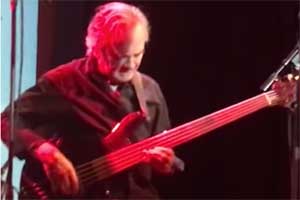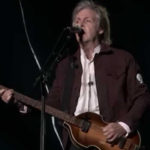Welsh bass legend recounts his early years, the Liverpool scene, Brand X and Tunnels, as well as his fascination with the fretless bass!
Exclusive interview with FBPO’s Jon Liebman
September 27, 2010
Fretless electric bassist Percy Jones has carved out his place in progressive rock and jazz-fusion and is considered by many to be one of the greatest bass players in the world. A native of Wales, Mr. Jones began his career as a notable bass player with the bands Liverpool Scene and Scaffold in the U.K. He is a founding member of BRAND X, a pioneer jazz-rock fusion outfit, where he worked alongside John Goodsall, Robin Lumley and Phil Collins of Genesis. Percy was also a longstanding member of the jazz-rock fusion band Tunnels.
Throughout his career, Jones has collaborated with Brian Eno, Suzanne Vega, Bill Frisell, Roy Harper, Richard Barbieri, Nova, Project Lo, Elliott Sharp, David Sylvian, Masami Tsuchiya, Bobby Previte and many others. He has toured extensively throughout the United States, Europe and Japan as a solo artist as well as a bass player in various bands.
FBPO: Tell me about your musical upbringing. Weren’t you originally influenced by the “pure” jazz guys, like Miles, Mingus and Coltrane?
PJ: I originally listened to British R&B groups and American blues musicians. Some of the British bands included Graham Bond, Alexis Korner and Georgie Fame. I also listened to a lot of American blues players, including Howlin’ Wolf, Muddy Waters and Sonny Boy Williamson. Actually, Georgie Fame had an excellent electric bass player called Cliff Barton, who made a big impression on me back in the late ’60s.
I remember seeing Alexis Korner doing a gig in Hereford. He was using bassist Danny Thompson and drummer Terry Cox. Alexis was a blues player, but the rhythm section had a strong jazz flavor with a lot of syncopation. It was an interesting hybrid and it got me into exploring jazz.
Later on, Mike Evans in the Liverpool Scene introduced me to the music of Charles Mingus and I was hooked from that point on. This led to getting into Miles, Coltrane and numerous other jazz people.
FBPO: What can you tell me about your earliest gigs? How did you establish yourself as a musician?
PJ: My earliest gigs were playing around mid Wales in the early to mid ’60s with a band called The Viceroys, which mostly played R&B stuff. There wasn’t really anybody in the area who taught electric bass, so I was pretty much self-taught. It was a period of cutting my teeth and learning the basics of playing a bass.
FBPO: Can you identify a turning point or a defining moment when you realized you were going to make your living as a bass player?
PJ: In 1966, I went to Liverpool to study electronic engineering at the university there. I joined a band with a bunch of other students and we started gigging around a bit. Adrian Henri was fronting an outfit called the Liverpool Scene and I was invited to join. It was originally a poetry and music band, but it gradually morphed into a rock & roll band with whiffs of jazz and blues. We originally were doing gigs locally, at the Cavern Club, O’Connors Tavern and the Everyman Theatre, but then, starting around 1968, we got into the burgeoning UK pub club circuit and became quite busy. I then had to make a choice of being an electronics engineer or a bass player. For better or for worse, I chose the latter.
FBPO: What attracted you to the fretless bass? What is it about the instrument you find so alluring?
PJ: I always liked the electric bass because I loved all the low end stuff and the volume you get could get with an amp. At the same time, I admired upright players for their chops and their tone. Mingus was a big favorite. My first two basses were fretted, though on the second one, which was a big, extra-long scale hollow-bodied Gretsch, I filed down the frets under the top string, so it was sort of a fretted/fretless hybrid. In 1974 I saw an ad in Melody Maker for a Fender Precision fretless, so I grabbed it and immediately felt comfortable with it. I felt it was a happy medium for what I wanted to do.
FBPO: How did Brand X come about?
PJ: It’s a long story, but to simplify it slightly, I was invited to some regular Wednesday night jam sessions by Robin Lumley. By this time, 1973, I had moved to London and was working on a construction site. The weekly sessions continued for a while and somebody in the band managed to hook up an audition with Island Records. Island miraculously signed us up, despite the fact that we were playing some pretty outside stuff!
We recorded an album for Island, which had vocals on it. Island liked it but we didn’t, so we asked if we could do another record and make it all instrumental. Island agreed and we recorded another album. By this time, Phil Collins had taken over the drum chair. Island didn’t like this record and gave us the boot. Luckily, Charisma took the record and released it. This was Unorthodox Behaviour, our first record. Things pretty much rolled along from there on.
FBPO: How about Tunnels?
PJ: In the late ’80s I was living in New York, playing quite a few solo gigs with a sequencer and synched 4-track cassette deck. I had released my solo record, Cape Catastrophe, which included most of this solo material. I wanted to work with a band again to play some of this material, so I started looking for people to play with. Ultimately Marc Wagnon joined on MIDI vibes and Frank Katz on drums. Guitar player Van Manakas came in for a while also. Tunnels continued for several years and recorded five records.
FBPO: You’ve done a lot throughout your varied career. Do you have a good story you can share? Something that really stands out?
PJ: There are a few, but one that comes to mind was when I was recording with Big Jim Sullivan and Simon Phillips. We were recording a tune and I was reading a chart that Big Jim had written. I noticed everything sounded kind of strange and I noticed Big Jim looking over at me a few times. Anyhow, we all continued and finished the take. I remember thinking, “Wow, this is some interesting harmony!” It turned out I was reading a chart for another tune.
FBPO: What’s keeping you busiest these days?
PJ: I’m doing assorted recording and gigging. The Bang Tower record is finished and it comes out in September. The McGill/DeCarlo/Jones CD is out. I did a track on Edo Castro’s record, which I think is out. I’m going to record a couple of tracks on a new Mawwal record later this month, too.
I’ve been doing some gigs locally, mostly in swinging Brooklyn, with drummer Steve Moses of Alice Donut. It’s all improv, so it’s a period of experimentation and exploring new ideas.
FBPO: What would you like to accomplish that you haven’t already done?
PJ: I’d like to break some new ground and get some new concepts going. It’s a never-ending quest.
FBPO: What do you like to do that’s not necessarily musically oriented?
PJ: I’ve had an interest in ham radio since I was a kid. I’ve got a fascination with waves and the movement of energy through space, not just electromagnetic waves but even acoustic waves in the atmosphere.



